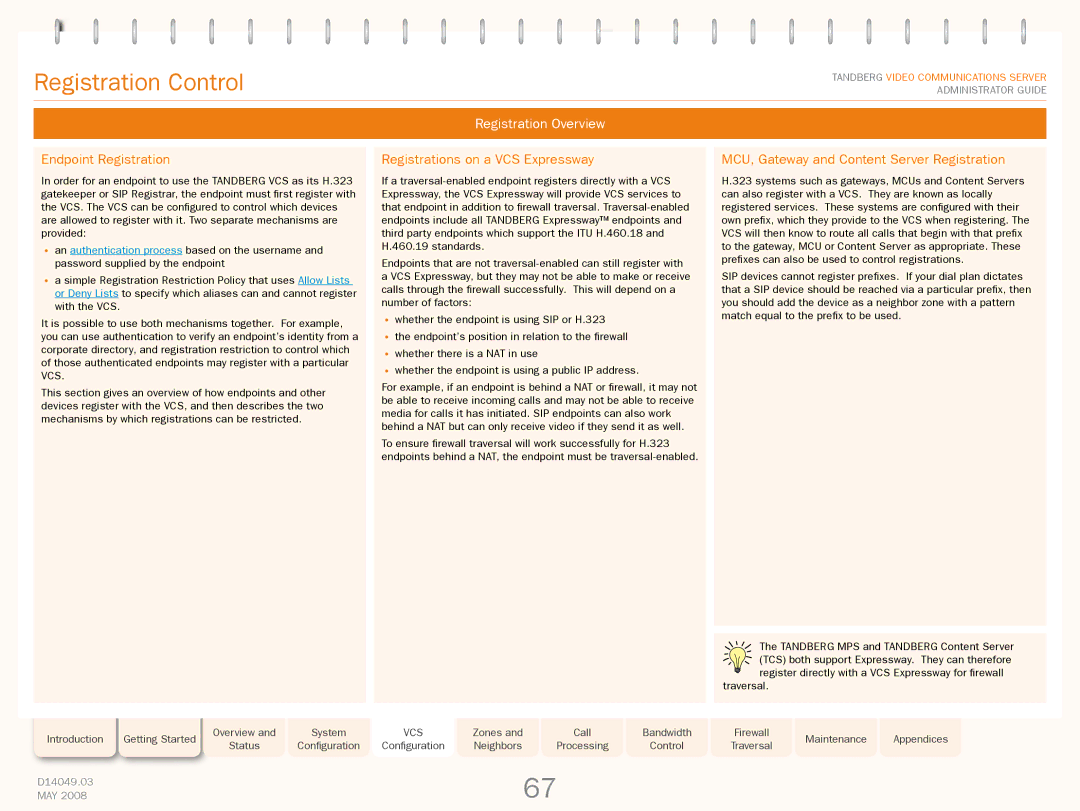
Grey Headline (continued)
Registration Control
TANDBERG VIDEO COMMUNICATIONS SERVER ADMINISTRATOR GUIDE
Registration Overview
Endpoint Registration
In order for an endpoint to use the TANDBERG VCS as its H.323 gatekeeper or SIP Registrar, the endpoint must first register with the VCS. The VCS can be configured to control which devices are allowed to register with it. Two separate mechanisms are provided:
•an authentication process based on the username and password supplied by the endpoint
•a simple Registration Restriction Policy that uses Allow Lists or Deny Lists to specify which aliases can and cannot register with the VCS.
It is possible to use both mechanisms together. For example, you can use authentication to verify an endpoint’s identity from a corporate directory, and registration restriction to control which of those authenticated endpoints may register with a particular VCS.
This section gives an overview of how endpoints and other devices register with the VCS, and then describes the two mechanisms by which registrations can be restricted.
Registrations on a VCS Expressway
If a
Endpoints that are not
•whether the endpoint is using SIP or H.323
•the endpoint’s position in relation to the firewall
•whether there is a NAT in use
•whether the endpoint is using a public IP address.
For example, if an endpoint is behind a NAT or firewall, it may not be able to receive incoming calls and may not be able to receive media for calls it has initiated. SIP endpoints can also work behind a NAT but can only receive video if they send it as well.
To ensure firewall traversal will work successfully for H.323 endpoints behind a NAT, the endpoint must be
MCU, Gateway and Content Server Registration
H.323 systems such as gateways, MCUs and Content Servers can also register with a VCS. They are known as locally registered services. These systems are configured with their own prefix, which they provide to the VCS when registering. The VCS will then know to route all calls that begin with that prefix to the gateway, MCU or Content Server as appropriate. These prefixes can also be used to control registrations.
SIP devices cannot register prefixes. If your dial plan dictates that a SIP device should be reached via a particular prefix, then you should add the device as a neighbor zone with a pattern match equal to the prefix to be used.
|
|
|
|
|
|
|
|
|
|
|
|
| The TANDBERG MPS and TANDBERG Content Server | |||||
|
|
|
|
|
|
|
|
|
|
|
|
| (TCS) both support Expressway. They can therefore | |||||
|
|
|
|
|
|
|
|
|
|
|
|
| register directly with a VCS Expressway for firewall | |||||
|
|
|
|
|
|
|
|
|
|
|
| traversal. |
|
|
|
|
| |
|
|
|
|
|
|
|
|
|
|
|
|
|
|
|
|
|
|
|
Introduction | Getting Started |
| Overview and |
| System | VCS | Zones and |
| Call |
| Bandwidth |
| Firewall |
| Maintenance |
| Appendices |
|
| Status |
| Configuration | Configuration | Neighbors |
| Processing |
| Control |
| Traversal |
|
|
| ||||
|
|
|
|
|
|
|
|
|
|
|
| |||||||
|
|
|
|
|
|
|
|
|
|
|
|
|
|
|
|
|
|
|
D14049.03 |
|
|
|
|
|
| 67 |
|
|
|
|
|
|
|
|
| ||
MAY 2008 |
|
|
|
|
|
|
|
|
|
|
|
|
|
|
| |||
